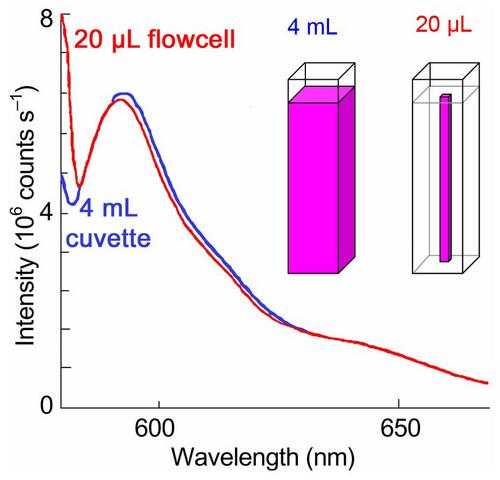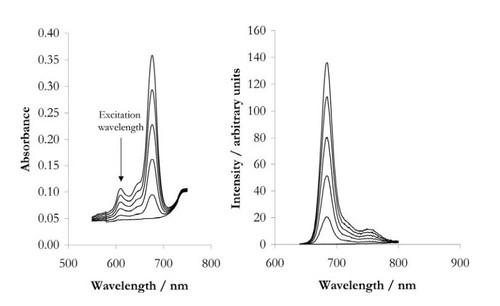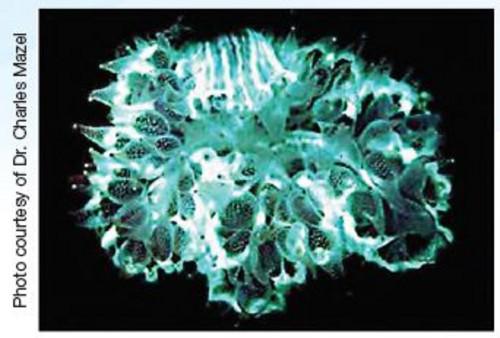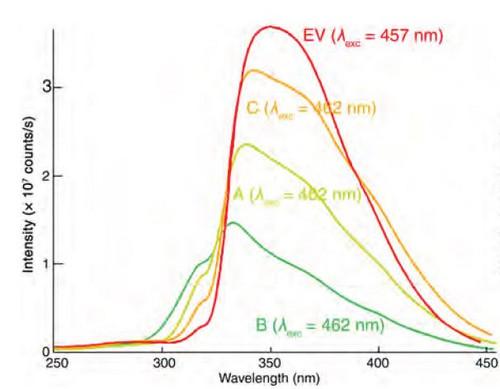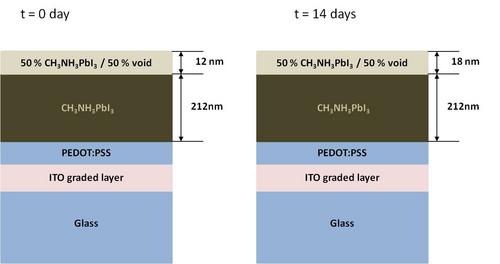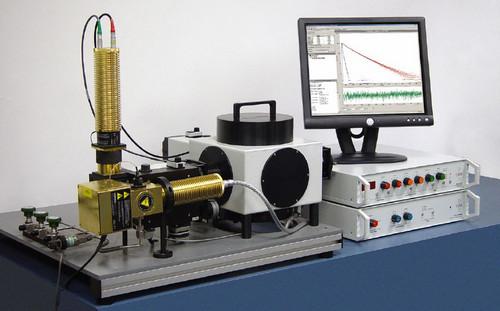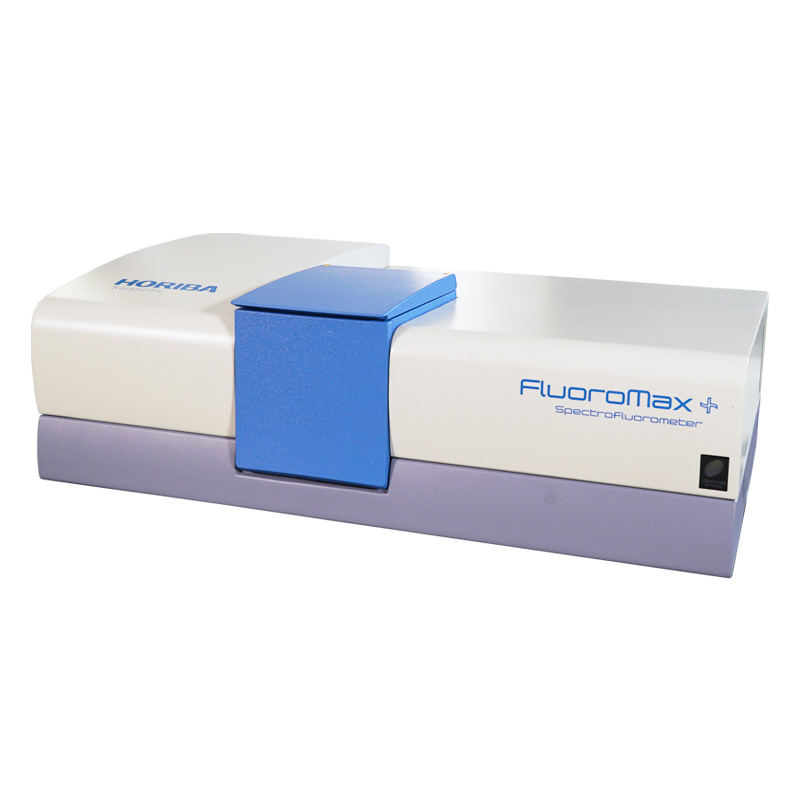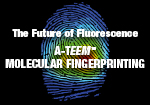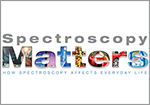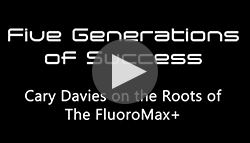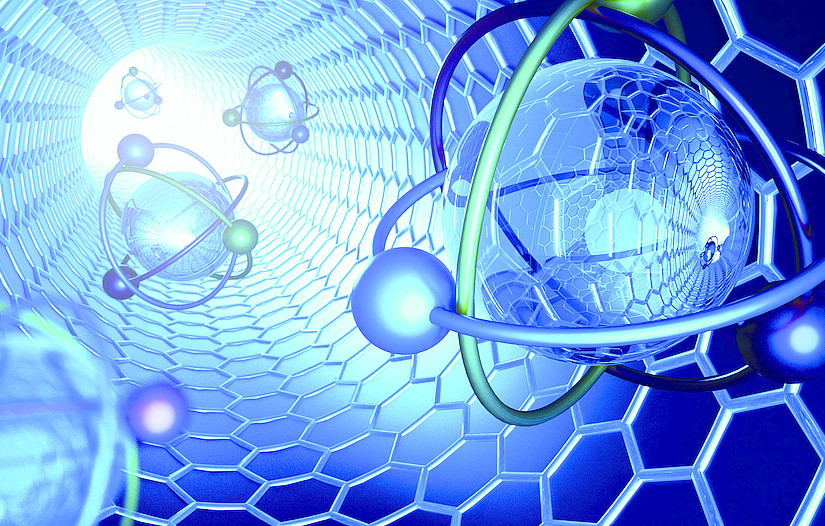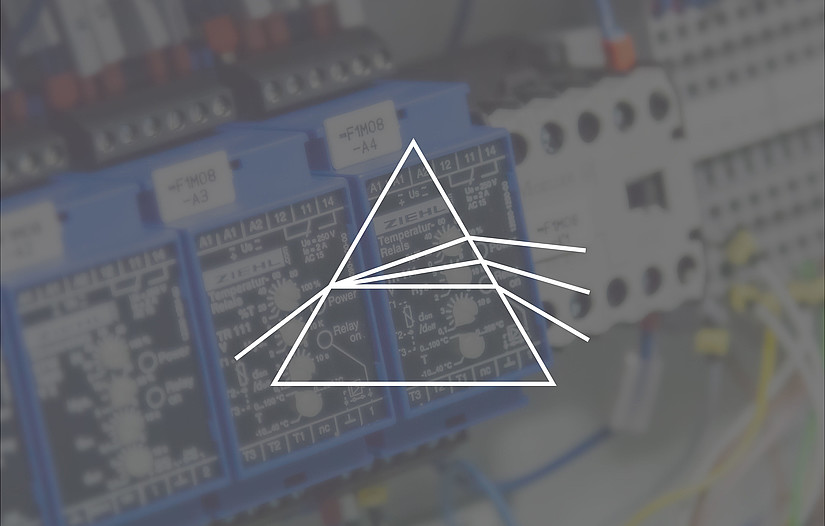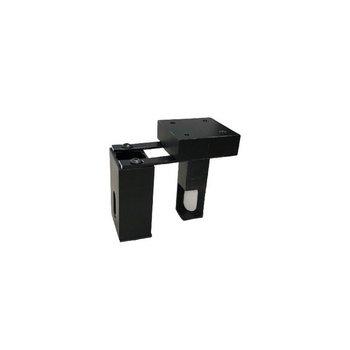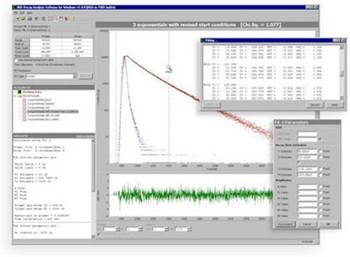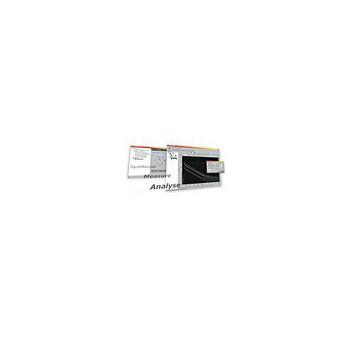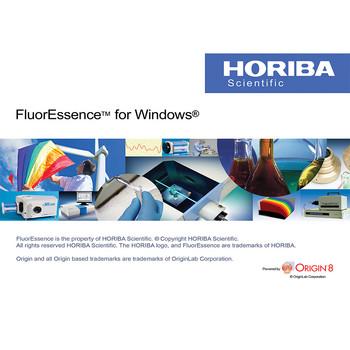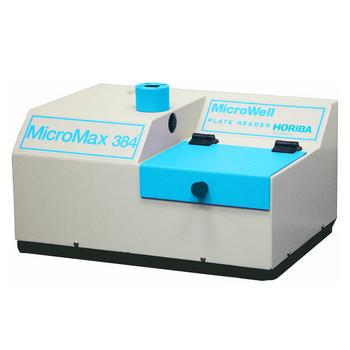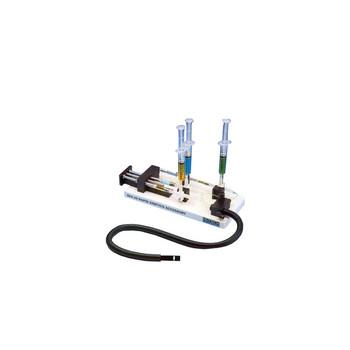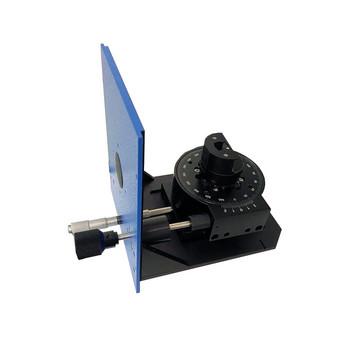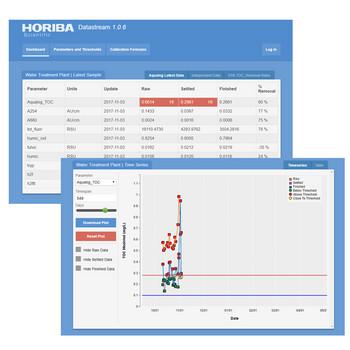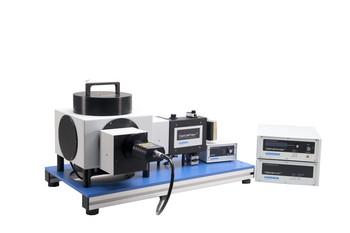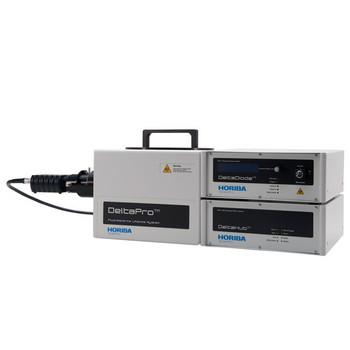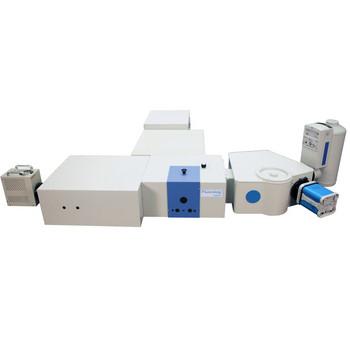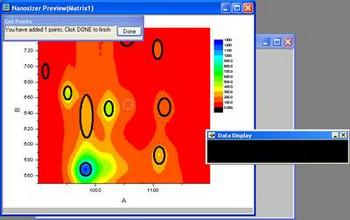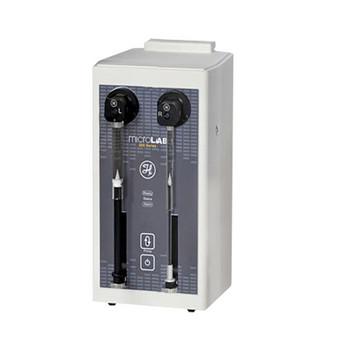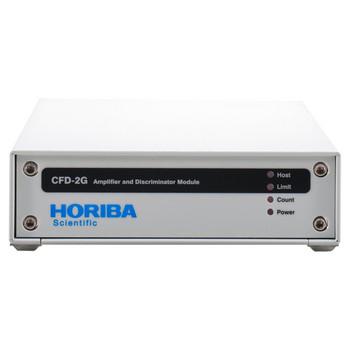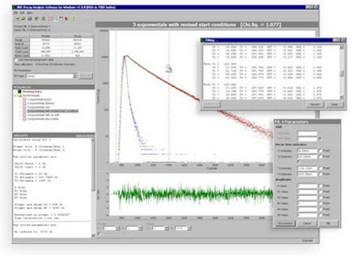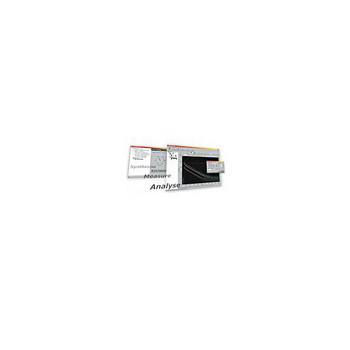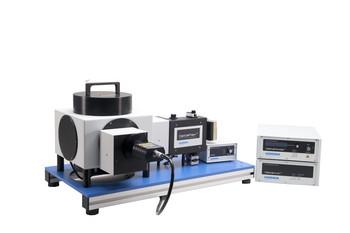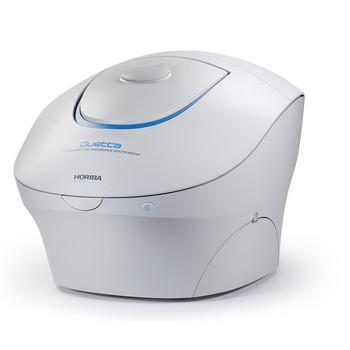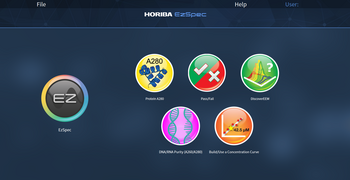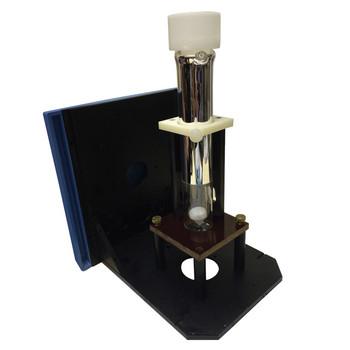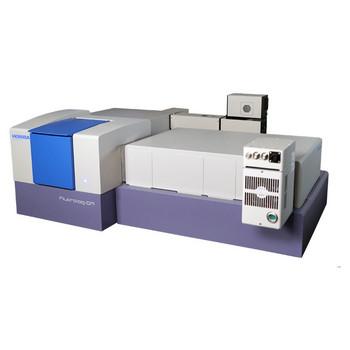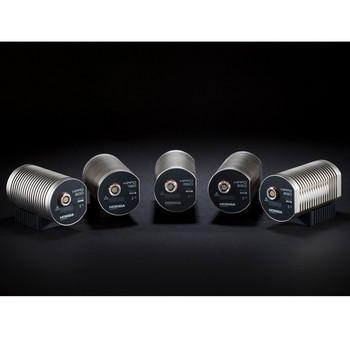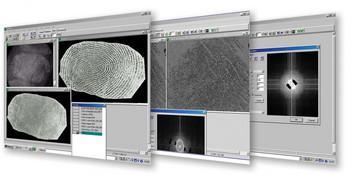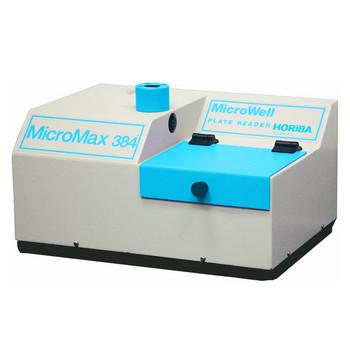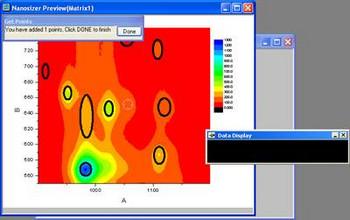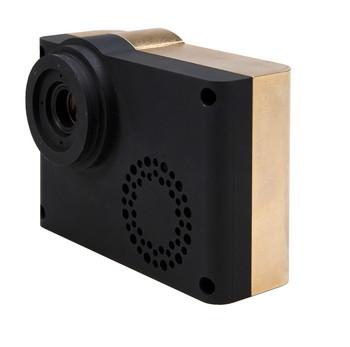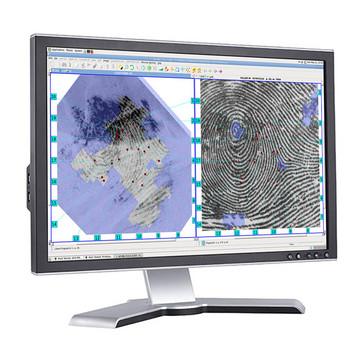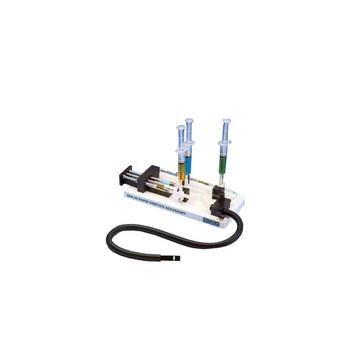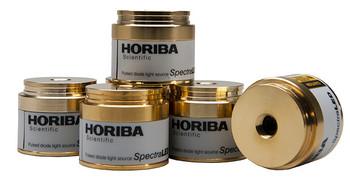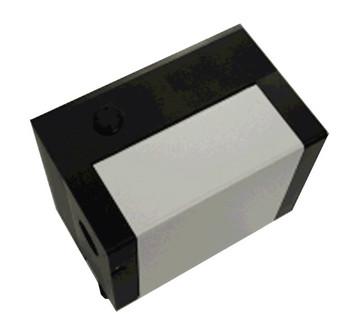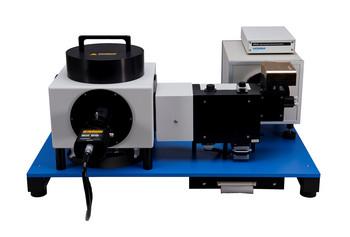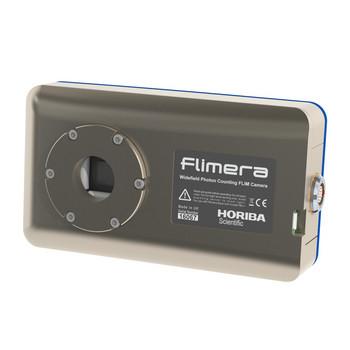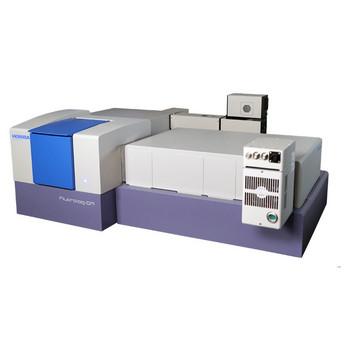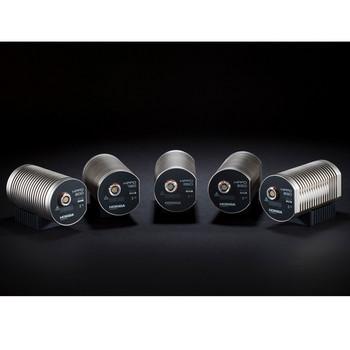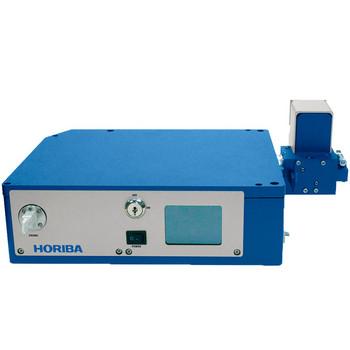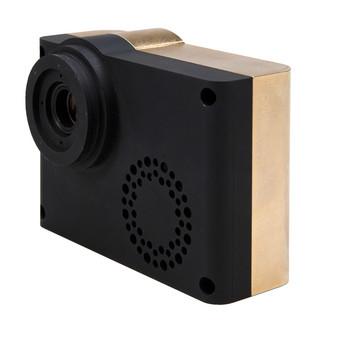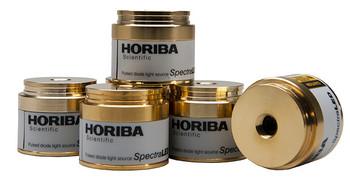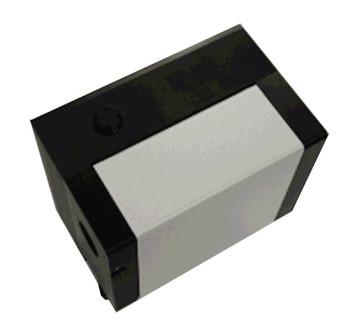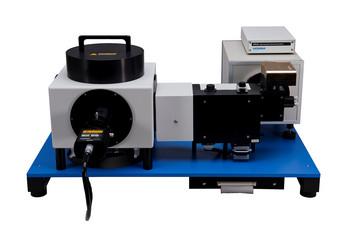| Lamp | Vertically mounted, CW, 150 W Ozone-free xenon arc lamp |
| Gratings | 1200 groove/mm blazed at 330 nm (excitation) and 500 nm (emission), plane ruled |
| Automatic self-calibration of all wavelength drives and slits | |
| Monochromators | All reflective optics, Czerny-Turner spectrometers |
| Detectors | Emission: R928P photon counting PMT (185-850 nm) and reference photodiode for monitoring lamp output |
| Water Raman S/N | 10,000:1 (FSD method). See Signal-to-noise ratio |
| Slits | Continuously variable from 0 to 29 nm |
| Accuracy | 0.5 nm |
| Repeatability | 0.1 nm |
Minimum step | 0.0525 nm |
Integration time | 0.001 to 160 sec |
Software | FluorEssence |
Spectral Correction Factors | Included |
FluoroMax Plus
Steady State and Lifetime Benchtop Spectrofluorometer
The FluoroMax® Plus represents HORIBA's industry-leading fluorometer performance in a convenient, affordable, easy-to-use benchtop model. The FluoroMax family, with its unique all reflective optics and photon counting was the first to bring the sensitivity of a modular fluorometer to a tabletop fluorescence instrument, in the 1990's.
It’s a compact spectrofluorometer, yet offers the ultimate sensitivity in fluorescence investigations as well as features not found in most table-top fluorescence detection systems.
The FluoroMax Plus is the latest generation of the original, high performance tabletop fluorometer, which offers extended performance with detection of emission spectra out to 1700 nm and (TCSPC) Time Correlated Single Photon Counting lifetime measurements as short as 25ps.
FluoroMax Plus spectrofluorometers are the most senstive, flexible and trusted benchotop spectrofluorometers in the world.
Featured Videos
Features
- Water Raman signal-to-noise ratio: 10,000:1 (FSD method)
- Photon Counting for Ultimate Sensitivity
- Fast Scanning capability - up to 80 nm/second
- Powerful FluorEssence™ software for Windows®
- Method Files to recall complete experiment parameters
- Time-correlated single-photon counting (TCSPC) accessory for lifetime determinations
- Phosphorimeter accessory for long-lived luminescence determinations
Hardware
The Source
The xenon source that supplies prime UV performance is focused onto the entrance slit of the excitation monochromator with an elliptical mirror. Besides ensuring efficient collection, the reflective surface keeps all wavelengths focused on the slit.
As an option an additional, software-selectable, xenon flash lamp can be fitted to enable phosphorescence studies.
Optional Pulsed Laser and LED Light Sources.
The Slits
The slits themselves are bilaterally, continuously adjustable from the computer in units of bandpass or millimeters. This preserves maximum resolution and instant reproducibility.
The Excitation Monochromator
The excitation monochromator is an aspheric design which ensures that the image of the light diffracted by the grating fits through the slit. The gratings themselves are plane, blazed gratings that avoid the two major disadvantages of the more common concave holographic gratings: poor polarization performance and inadequate imaging during scans that throws away light. The unique wavelength drive scans the grating at speeds as high as 80 nm/s. The grating grooves are blazed to provide maximum light in the UV and visible region.
The Reference Detector
Before the excitation light reaches the sample, a photodiode reference detector monitors the intensity as a function of time and wavelength. The photodiode detector has a wider wavelength response than the older, traditional rhodamine-B quantum counter, and requires no maintenance.
The Sample Chamber
A spacious sample chamber is provided to allow the use of a long list of accessories for special samples, and encourages the user to utilize a variety of sample schemes.
The Emission Monochromator
All the outstanding features of the excitation monochromator are also incorporated into the emission monochromator. Gratings are blazed to provide maximum throughput in the visible region.
The Emission Detector
Emission detector electronics employ photon-counting for the ultimate in low-light-level detection. Photon-counting concentrates on signals that originate from fluorescence emission, ignoring smaller signals originating in the detector tube (PMT). The more common method of analog detection (used by lower performance fluorometers) simply adds noise and signal together, masking weak emissions.
The emission detector housing also contains an integral high-voltage supply which is factory set to provide the signal-to-noise ratio.
Computer Control
The entire control of the FluoroMax originates in your PC with our FluorEssence™ software and is transmitted through a USB link. On start-up, the system automatically calibrates and presents itself for new experiments, or stored routines instantly called from memory.
Accessories
A wide variety of accessories are applications-oriented and most are interchangeable with the FluoroMax system.
FluorEssence Steady State Software
FluorEssence - Steady State Software
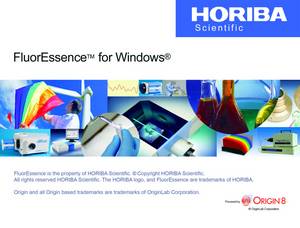
FluorEssence™ for Windows® sets a new standard for fluorescence software. FluorEssence™ merges spectrofluorometer data-acquisition directly to the famous processing power of Origin® software.
Simple clicks let you select a scan type, accessory or bring back a complete experimental set-up.
Revolutionize the Way You Operate Your Spectrofluorometer:
- Simplified windows make data-acquisition intuitive even to the casual user.
- With detector algebra, assemble input signals from different detectors into unique equations (including arithmetic or transcendental functions) that produce data in a format tailored to your application.
- Select the special Real Time Control (RTC) window to optimize your run parameters before actually scanning.
- Free video tutorials make FluorEssence™ even easier to learn.
- Run a variety of accessories including polarizers, microwell-plate readers, temperature baths, autotitrators, phosphorimeters, and more.
- Automatic correction for blanks and lamp output.
- Change units for temperature, wavelength, and slit-width with the click of a mouse.
FluorEssence™ also includes the powerful processing and data-management tools of Origin® to streamline your laboratory’s operation.
Data-viewing, plotting, processing and management are all available, including extensive import and export facilities, view manipulation and creation, arithmetic applications, peak-picking and integration, data- management and much more!
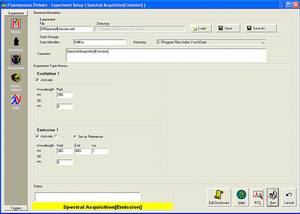
Software Features
- Data views in Workbook formats, keeping graphs, tables and notes together for each experiment
- Zooming and scaling
- Contour maps and profiles from 3D plots
- Integration/DerivativeFit fluorescence data to Gaussian, Lorentzian, and custom curves
- Standard arithmetic
- 3D perspective
- Smoothing
- Deconvolute
- Excitation/emission correction
- Interpolation and extrapolation
- Blank subtraction
- Normalization
- PLQY calculator wizard (for use with Quanta-Phi accessory)
DAS6 Decay Analysis Software
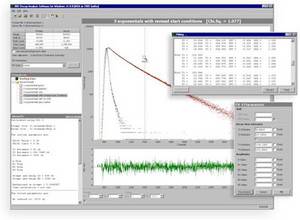
HORIBA Scientific decay analysis software recovers kinetic information (such as fluorescence lifetime and rotational correlation times) from luminescence decay data by fitting the raw decay data to one of a selection of kinetic models. Features such as shift iteration and reconvolution of instrument response function (IRF, or "lamp" profile) allow accurate recovery of multiple decay components even when the decay data is grossly distorted by the IRF.
DAS6 is designed to streamline the analysis of time-domain luminescence data, while still allowing for fine-tuning of parameters where necessary. Analysis modules include reconvolution analysis of multi- exponential models plus analysis of more specialised fluorescence decay processes as detailed below.
Multi-Exponential
Analysis for up to 5 exponentials.
Batch Exponential
Batch mode supports datasets containing up to 10,000 decays and is ideal for applications where large amounts of lifetime data are generated e.g. lifetime imaging and reaction monitoring. It features full reconvolution with up to five exponentials and shift iteration.
Global Exponential
Perform global analyses of up to 5 exponential components and 100 decay curves.
Distribution
Two methods are available for performing lifetime distribution analysis. The first method employs a “Top Hat” distribution function which allows a single lifetime distribution to be fitted in conjunction with an additional discrete lifetime. The second method is an optional module which will perform a Non-Extensive Decay distribution which allows up to five lifetime distributions to be modelled.
Exponential Series
Exponential series analysis of up to 30 terms. This allows parameterisation of otherwise difficult data.
Foerster Energy Transfer
2D and 3D Foerster type energy transfer with an optional exponential component.
Yokoto-Tanimoto Energy Transfer
Yokoto-Tanimoto energy transfer taking into account diffusion with an optional exponential component.
Micellar quenching
Micellar quenching kinetics can help determine the surfactant aggregation number.
Exciplex
Exciplex analysis follows formation of an excited state species.
Anisotropy analysis
Impulse reconvolution of up to 2 correlation times and 5 fluorescence decay components. Each model parameter, including shift, can be fixed at a pre-determined value or optimised as part of the parameter fitting. The use of reconvolution allows accurate determination of decay times and rotational correlation times even when the observed decay is grossly distorted by the duration of the excitation pulse.
DataStation TCSPC Acquisition Software
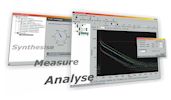
DataStation is the latest measurement environment for time-domain fluorescence and is supplied with all HORIBA Scientific lifetime systems.
Lifetime systems are made up of various modules and components, including pulsed light sources, PMTs, monochromators, motorized polarizers, focusing optics, MCAs etc. DataStation integrates the control of all these components into one intuitive, mouse-driven Windows environment.
Lifetime systems can perform a variety of measurement functions, such as fluorescence decay measurement, phosphorescence decay measurement, time-resolved anisotropy measurements, steady-state spectra, time-resolved emission scan (TRES), temperature scans and more. These measurements are now routine using DataStation. Measurement templates are provided to quickly set up the instrument for the required measurement, and automated data acquisition is performed using computer controlled components.
Acquired data can be saved in a variety of formats including the .das format, HORIBA Jobin Yvon IBH v4.2, and ASCII, printed to your Windows printer, exported or copied to the clipboard for manipulation using a third-party application.
DataStation can be purchased separately for use on non-HORIBA Scientific systems, and we are happy to add custom functionality and interfacing (e.g. to additional monochromator types, motorized polarizer holders etc).
The DataStation software comes into its own when combined with a FluoroHub.
Functionality
DataStation evolves continually as new functionality is added in response to customer suggestion. The following is a partial list:
Graphical
- Log or linear y-axis.
- Auto scaling y-axis.
- Multiple mouse zoom modes - x only, y only, x and y, pan, reset.
- Reversed time-axis mode (automatically reverses data during reversed-TAC mode measurements).
- Live display of cursor position, peak count, peak channel and total count.
- Detachable and customizable toolbars with helpful hints.
- Context-sensitive pop-up toolbars.
- Intuitive tree navigation for files and hardware settings.
- Tree navigation control window for FluoroHub control.
- Real-time estimated average lifetime during acquisition.
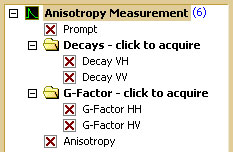
TCSPC mode
- Measurement presets - peak count or elapsed time.
- Multiple traces on screen simultaneously.
TRES mode
- Configure instrument for scan operation in just a few mouse clicks.
- Scan excitation or emission monochromator.
- Records 3D data (counts vs time vs wavelength) with live 3D progress display and interactive rotation.
- Manual and automatic data slicing.
Anisotropy mode
- Target difference count.
- G-factor measurement.
MCA support
- Canberra/Tennelec PCA3.
- EG&G/Perkin Elmer Ortec Trump card.
Monochromator support
Polarizer support
- HORIBA Scientific 5000U-02 polarizers.
- PRA polarizers.
Temperature control support
- HORIBA Jobin Yvon IBH dipstick temperature controller (as accessory to HORIBA Scientific 5000 series system only).
- Cryostat (as accessory to HORIBA Scientific 5000 series system only).
System Requirements
The following PC specification are required to run DataStation. Measurement functionality depends on spectrometer hardware attached. Basic operation requires a supported MCA card or FluoroHub. Contact HORIBA Scientific for more information.
1 Gb RAM, 1 Gb HD space, DVD drive, 1024x768 graphics with minimum 256 color support, mouse or other pointing device. Windows™ XP or later (XP/Vista/7). Windows™ XP recommended.


